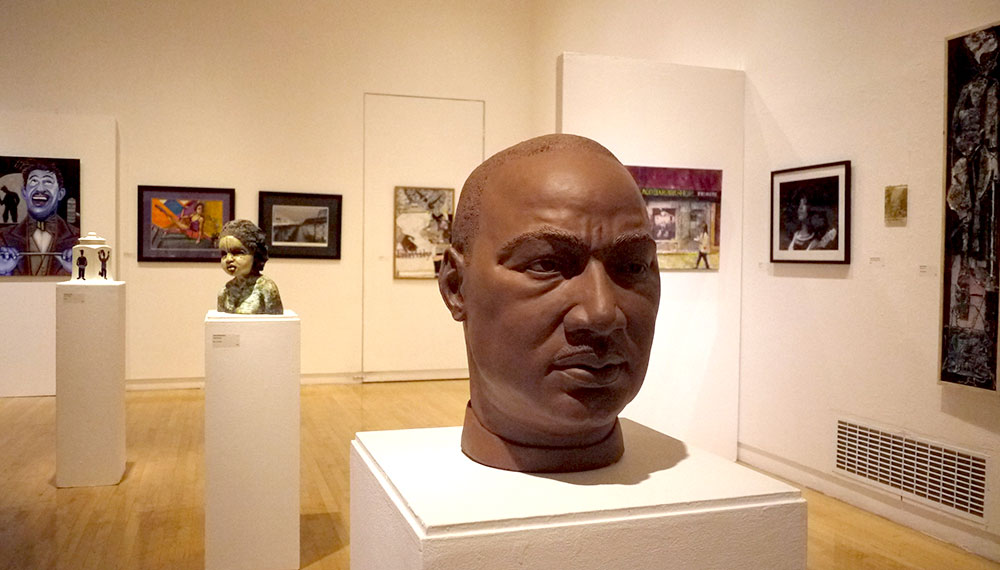The Art of Living Black exhibition has transformed our main gallery with the works of 75 Bay Area artists. Two of these artists, Yolanda Holley and Atiba Sylvia Thomas, sat down and talked with writer Lou Fancher on how this exhibition and their art are important for the community of artists that come together each year. The exhibition is up through February 27.
Annual Richmond Exhibit Provides Showcase for Black Artists
Contra Costa Times
By Lou Fancher
There are angry answers to questions about why the general public can easily remember the accomplishments of African American athletes and pop music stars, but forget people like Romare Bearden, (1911-1988), a brilliant writer and artist whose collages established him as a preeminent artist of the 20th century.
Locally, cries of complaint can be the reaction when visiting celebrities of color receive greater consideration than Bay Area artistic talent from the black community.
That void of attention was a driving force behind the creation and growing popularity of “The Art of Living Black,” a free community-boosting art exhibit.
Capturing the visual art of 50 regional artists of African descent, the 19th annual exhibit has its origins in metaphorically bare walls, after the late sculptor Jan Hart-Schuyers and late painter Rae Louise Hayward noticed that black artists were not being represented at exhibits.
Last year, TAOLB then-president Steve Hopkins, Hayward’s husband, told the San Francisco Chronicle that the two artists had noticed the dearth of works by black artists on gallery walls nearly 20 years ago and had set out to “bring all these good people together and have them on display.”
The show has continued after Hayward’s death in 2008 and gained momentum from what participating artist Yolanda Holley said in an interview is an improving landscape.
“There are more opportunities available for African American artists now,” the 63-year-old San Pablo resident said. “This was established during a difficult time: It was a need-creation. Many people didn’t think we existed.”
Holley said she found an artistic home when she first gained entry to the exhibit in 2003.
African American resiliency rooted in slavery and surviving in the fabric of family connections weaves her art and life history into joyful unity.
“I’ve always been drawn to color and my parents taught me you can be happy without material things. I live simply,” she said.
Her family background is rooted in the 135-year-old church she attends, where she finds “my mother, grandfather, myself, spread over 100 years.”
Holley’s work “In Time,” its flattened perspective and human face without details reminiscent of early 20th century African American folk art, demonstrates transition, Holley said.
“Man didn’t create time and she can’t control it,” she said about the woman in the painting, who is more symbol of pliable vulnerability than a specific character.
Another work, “Two,” felt heavy, she said, until layer upon layer of dryer sheets provided the lightness and transparency she sought.
“Through art, I can express not just living as a black artist, but living as a person,” Holley said. “I tell my stories and even accept rejection. I’m in awe of people who enjoy seeing my work.”
Exhibit participant Atiba Sylvia Thomas, who teaches art at East Oakland Leadership Academy charter school, said her mixed media assemblages have been in process since even before her childhood.
“During slavery, we had to make the best of what we had. Scraps thrown out by the master, discarded things, we made beautiful things. We brought our heritage from Africa and though they took if from us, we reclaimed it,” Thomas said.
Thomas incorporates African fabrics and found objects like the rusted chains and bits of steel used in “Hope Is Where It’s Going” — molding them into hearts or other shapes and even incorporating bits of her own dreadlocks in the work.
“It’s a part of me — right in the artwork,” she said.
Thomas said she will bring her students, who admiringly call her assemblages “junk art,” to the exhibit.
“They beg me to do junk art. They realize you can make something out of anything. I tell them they are creative geniuses; it keeps them from thinking they are only not good at math, or only good at sports.”
Thomas said it’s impossible for her to make art without including what is happening to “my people” and has recently completed a piece for a “Black Lives: Art & Justice Matter” exhibit at the Women’s Cancer Resource Center in Oakland.
Describing a series of pieces she made last year, she said a missing chunk in one piece represents a time when she despaired, while nails aimed at a heart point to recovery and hope for everyone.

